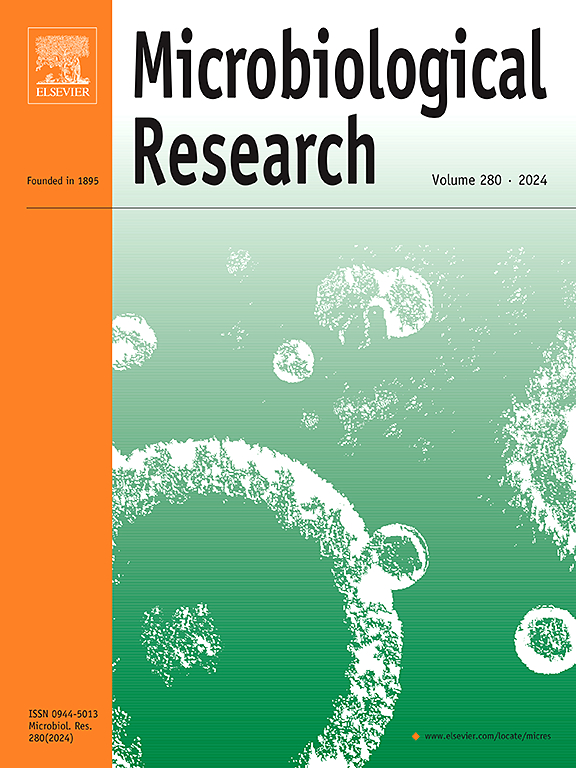Characterization of novel Erwinia amylovora-specific phiEaSP1 phage and its application as phage cocktail for managing fire blight in apples
IF 6.1
1区 生物学
Q1 MICROBIOLOGY
引用次数: 0
Abstract
Erwinia amylovora (Ea) is a devastating bacterial pathogen that causes fire blight disease in Rosaceae family plants, including apples and pears. The use of bacteriophages is an alternative strategy to antibiotics for managing bacterial pathogens. In this study, the Ea-specific virulent phiEaSP1 phage was characterized, and its biocontrol efficacy against Ea was evaluated in apple seedlings. Genomic analyses revealed that phiEaSP1 belongs to the family Chaseviridae, subfamily Cleopatravirinae, and genus Loessnervirus. Most phiEaSP1 particles bound to the host cell surface within 5 min, and one virion made 68 progenies within 20 min of infection. The phage rapidly lysed Ea cells in vitro and maintained its lytic activity after incubation under different environmental conditions, including temperature, pH, and UV-A, as well as in the soil, with surfactants, and on apple seedlings. Receptor analysis using the Tn5 random mutant library of Ea TS3128 demonstrated that phiEaSP1 recognizes lipopolysaccharide as a receptor, whereas phiEaP-8 and phiEaP-21 recognize cellulose as a receptor. Protective efficacy against fire blight was tested on apple seedlings pretreated with the single phiEaSP1 or a phage cocktail containing phiEaSP1, phiEaP-8, and phiEaP-21. No or only weak symptoms were observed in the phage-treated seedlings. The application of a phage cocktail showed better control efficacy, indicating the potential of the phage cocktail, including phiEaSP1, as a preventive agent. Taken together, these results suggest that the use of a phage cocktail containing phiEaSP1 could be a potential strategy for the biocontrol of fire blight disease in apples.
新型淀粉状欧文菌特异性噬菌体phiEaSP1的鉴定及其在苹果火疫病防治中的应用。
淀粉状Erwinia amylovora (Ea)是一种毁灭性的细菌病原体,可引起蔷薇科植物(包括苹果和梨)的火疫病。使用噬菌体是控制细菌病原体的一种替代抗生素的策略。本研究对Ea特异毒力噬菌体phiEaSP1进行了鉴定,并对其在苹果苗上的防Ea效果进行了评价。基因组分析显示,phiEaSP1属于追逐病毒科、革流病毒亚科和Loessnervirus属。大多数phiEaSP1颗粒在5 min内与宿主细胞表面结合,一个病毒粒子在感染后20 min内产生68个子代。该噬菌体在体外快速裂解Ea细胞,并在温度、pH、UV-A等不同环境条件下,以及在土壤、表面活性剂和苹果幼苗上孵育后保持其裂解活性。利用Ea TS3128的Tn5随机突变文库进行受体分析表明,phiEaSP1识别脂多糖为受体,而phiEaP-8和phiEaP-21识别纤维素为受体。用单个phiEaSP1或含有phiEaSP1、phiEaP-8和phiEaP-21的混合噬菌体预处理苹果幼苗,研究其对火疫病的保护效果。在噬菌体处理的幼苗中没有观察到或只有微弱的症状。噬菌体鸡尾酒的应用显示出较好的防治效果,这表明包括phiEaSP1在内的噬菌体鸡尾酒具有作为预防药物的潜力。综上所述,这些结果表明,使用含有phiEaSP1的噬菌体鸡尾酒可能是一种生物防治苹果火疫病的潜在策略。
本文章由计算机程序翻译,如有差异,请以英文原文为准。
求助全文
约1分钟内获得全文
求助全文
来源期刊

Microbiological research
生物-微生物学
CiteScore
10.90
自引率
6.00%
发文量
249
审稿时长
29 days
期刊介绍:
Microbiological Research is devoted to publishing reports on prokaryotic and eukaryotic microorganisms such as yeasts, fungi, bacteria, archaea, and protozoa. Research on interactions between pathogenic microorganisms and their environment or hosts are also covered.
 求助内容:
求助内容: 应助结果提醒方式:
应助结果提醒方式:


